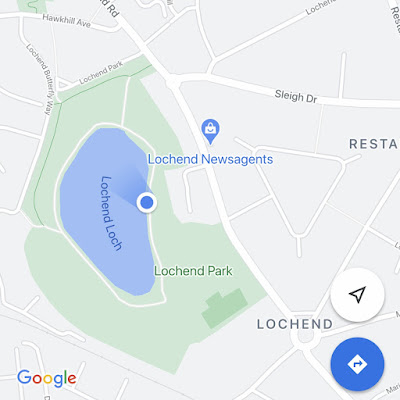I lived in the Abbeyhill area of Edinburgh years ago and remember the first time I stumbled across Lochend Park with it’s strange, little loch in the middle. It was a hot, humid summers day and the loch looked almost like something from a bayou in the southern United States with the trees growing out from the water.
Lochend Loch or Restalrig Loch is really just a large puddle that sits in a natural hollow in the ground and its depth varies with the rainfall. It used to serve as one of the main water supplies for Leith, but the water was of poor quality and often stagnant. The locals therefore preferred to get their water from the local wells instead.
The loch was also used for the hunting
of wildfowl and King James IV of Scotland hunted there occasionally.
Sometime in the 1570s the loch was the
site of the ghostly apparition of a fairy army.
Bessie Dunlop, a midwife, and folk healer from Ayrshire was on the way
to Leith and had stopped and tethered her horse by Restalrig Loch. As she was resting, she heard ‘a tremendous
sound of a body of riders rushing past her with a noise as if heaven and earth
would come together…the sound swept past her and seemed to rush into the lake
with a hideous rumbling noise. All this
while she saw nothing…’ (Letters on
Demonology and Witchcraft, by Walter Scott).
It would seem that a ghost she regularly spoke to informed her that this
was the fairies on one of their earthly processions. Alas for poor Bessie, she was later tried and
found guilty of witchcraft and in 1576 was executed on Castle Hill in
Edinburgh.
Above Lochend Loch sits Lochend House, which is also known as Restalrig Castle. The house used to belong to the Logan family, however it was confiscated from them by the Scottish Parliament in 1609, due to Robert Logan having been involved in a plot to abduct King James VI of Scotland. From 1704 it was owned by the 6th Duke of Balmerino, Arthur Elphinstone. He was beheaded on 18 August 1746 at Tower Hill in London for his part in the Jacobite rising if 1745. In 1816 most of the house was pulled down and a new house was built on the site. The property was recently renovated and is now privately owned.
There is a Doocot in the park which stands north from the house and next to a small, brightly coloured playground. It provided a nesting site for several hundred pairs of pigeons, which were used for eggs and meat. The Doocot is still popular with the local pigeons.
In 1645 the plague hit and devastated Leith, killing off around half the population (and we think we’ve got it bad with the Covid!). There is evidence of a chimney in the Doocot and it is thought it was used as an incinerator to burn the clothing and other items of those who fell victim to the plague. In old maps of the area, it is referred to as the ‘plague kiln’.
I left a Skulferatu by the loch as a present for the fairies, just in case they come by again. I hope they like it.
Latitude 55.960842
Longitude -3.159896
Article and
photographs are copyright of © Kevin Nosferatu, unless otherwise specified.











No comments:
Post a Comment